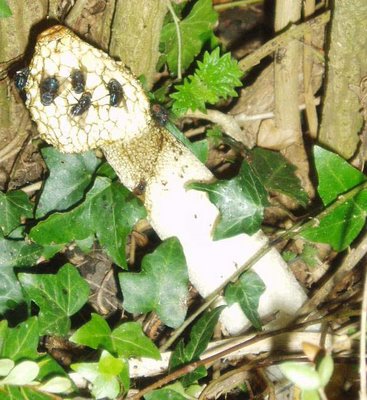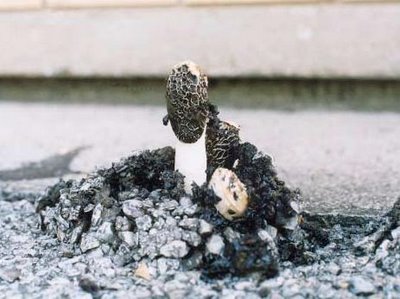I was alerted to the presence of the world’s most obscene fungus – the stinkhorn Phallus impudicus in the garden by the terrible stench that could be detected from a considerable distance.

The Stinkhorn Phallus impudicus
The stinkhorns are a fascinating fungi noted for their rapid growth, smell and unusual appearance.
“This is a fowl-smelling fungus that attracts flies to its spore-laden, slimy body, thus increasing the odds of its spores being dispersed to new habitats. The fruiting body can appear almost overnight, and may "scent" your entire back yard. ....This fungus begins as an egglike body beneath the soil. An erect phallus-like stalk breaks through the "egg," forming a cuplike basal volva as the stalk rapidly elongates. The swollen "head" or cap is coated with a black, putrid, musilaginous mass of spore slime.” (3) Mmm nice
The speed of growth is remarkable with a speed of 10-15cm per hour (1).

Phallus impudicus breaking through a pavement from ref. 1
The growing fungus can also exert a considerable amount of force being able to break a glass bottle if the ‘egg’ is allowed to grow inside and even break through tarmac with a force calculated to be 1,33 kN/m^2 so theoretically, one mushroom could lift a person weighing 133kg (1).
The smell that serves to attract flies that spread the fungal spores is astonishingly pungent and seems to do a good job (see pic.). The chemicals responsible seem to be: dimethyl disulphide, dimethyl trisulphide, Linalool, trans-ocimene, and phenylacetaldehyde (2). Interestingly dimethyl sulphide and trisulphide are important chemicals responsible for the bad smell of human flatulence, and seems to be a very effective attractant of various flies.
Because of its unusual shape, the fungus has unsurprisingly gained the reputation of being an aphrodisiac. It may be of some use is treating other medical conditions including epilepsy, gout and rheumatism. Apparently, it can also be eaten and is considered a delicacy in China and is sometimes mistaken for Morels by (presumably nose-less) fungus hunters. I doubt if I could stomach this particular delicacy.
Refs:
1) Is Phallus impudicus a mycological giant?
M. NIKSIC, I. HADZIC and M. GLISIC
Mycologist, Volume 18, Part 1 February 2004
DOI: 10.1017/S0269915X04001041
2) Dimethyl oligosulphides, major volatiles released from Sauromatum guttatum and Phallus impudicus
BORG-KARLSON A.-K; ENGLUND F. O; UNELIUS C. R.
Phytochemistry, 1994, vol. 35, no2, pp. 321-323.
http://cat.inist.fr/?aModele=afficheN&cpsidt=4067195
3) Wayne's World amazing fungi: http://waynesword.palomar.edu/ww0504.htm


4 comments:
I think Charles Darwins' sister used to hunt them out in the local woods, emasculating all she found in case the servants became inflamed by the mere sight of them. And they used to be pictured upside-down in textbooks of the time? Not that it's entirely clear how that would help...
(Ah, Stourbridge - home of glass, my parents and obscure 90's bands)
Thought you might like our stinkhorn timelapse.
In the states these appear around Indiana Dunes SP. They really do look like penii, but it is usually too windy there to smell them, thanks for the description -- Don Hersey
Post a Comment